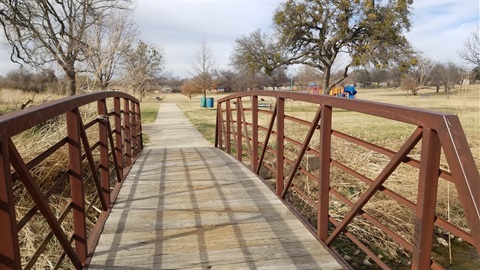Prairie Dog Park

Dedication
Size
Additional amenities
- Backstop
- Basketball court
- Bench
- Bleachers
- Bridge
- Drinking fountain
- Grill
- Park lighting
- Parking lot
- Playground area
- Restroom
- Shelter
- Soccer field
- Softball/baseball field
- Stand alone swing
- Table
- Tennis court
- Trash receptacle
Fun facts
In 1969, the Fort Worth City Council approved the acquisition of a 39.5-acre tract in the southeast section of the city. Park officials were eager to acquire the land because of its unique residents—prairie dogs. At the time of acquisition, it was believed that the colony was one of two in the area. Park & Recreation Department Director Charles Campbell was quoted as saying 'We believe they would provide an attraction for visitors to the park . . . Families could use the park for picnics and, at the same time, watch the prairie dogs scurry around.' The colony is believed to have had its origins from three pairs that were acquired for pets in the area of the old Parker-Henderson Road. The animals moved onto property owned by Earl Henderson where they quickly multiplied. By the 1960s, East Loop 820 and the Poly Freeway (later known as Martin Luther King, Jr. Freeway) were encroaching on and surrounding the colony. Unfortunately, the prairie dogs where not always compatible with other uses of the park such as when they tunneled into the baseball diamond. The animals were often the victims of cruelty or succumbed to predators. There are no prairie dogs in the park today.
History
The park was informally known as Parker-Henderson until the present name was adopted in 1970.
Recreation
The park has a 0.6 mile cement trail connecting the parking lot, playground, a footbridge across the stream, baseball/softball diamonds, and tennis courts.
Geology
The park is evenly split between Grayson Marl and Main Street Limestone Formations and the Woodbine Formation. Grayson Marl consists of greenish-gray thinly interbedded limestone with nodular bits of shale, sand and fossiliferous material. The Main Street Limestone is hard, thin interbedded gray and white layers. The Woodbine Formation, which was formed during the Late Cretaceous 95 million years ago in non-marine brackish water, and marine beds of sand, clay, sandstone, and shale measuring up to 600 feet thick. It is composed largely of Paleozoic sediment eroded from the Ouachita Mountains in southern Oklahoma and Arkansas and then deposited in ancient near-shore environments. It contains fossils such as ammonites, gastropods, pelecypods, brachiopods, and foraminifers. Most interestingly, one of the best examples of marine megafauna fossils in Texas is found in the Woodbine Formation in Arlington at the Arlington Archosaur Site. Theropod dinosaurs, duck-billed dinosaurs, croc-relatives, turtles, amphibians, snakes, mammals, bony fish, sharks, rays, invertebrates, and plant fossils have been found there. The catalogued fossils now reside at the Perot Museum of Natural History in Dallas.
Soils
The soils are a mix between Gasil series which consists of very deep, well drained, moderately permeable soils formed in deeply weathered loamy residuum derived from sandstones. The Pulexas series consists of very deep well drained, moderately rapidly permeable soils formed in stratified loamy alluvium.
Ecology
Prior to being a park, the area was under agriculture, specifically farming. Historically, the ecology of the site would have been riparian with upland Eastern Cross Timbers. The stream is an unnamed branch that flows directly into Village Creek and Lake Arlington. The park is maintained through mowing, but does have a narrow riparian buffer along the stream, which helps protect the banks from further erosion. Remnant Cross Timbers plants can still be found at the park including switchgrass, milkweed species, violet ruelia, Muhlenberg's sedge, and Ohio spiderwort. Interesting animals observed at the park include beaver and Blanchard's cricket frog.
See what plants and animals have been observed at Prairie Dog Park and help contribute to citizen science by reporting your observations by using the iNaturalist link in the sidebar.
Reserve this park on ActiveNet
Location
5060 Parker Henderson Road, Fort Worth 76119 View Map
32.6867172,-97.2578685
5060 Parker Henderson Road ,
Fort Worth 76119
5060 Parker Henderson Road ,
Fort Worth 76119
Prairie Dog Park
Photo Gallery